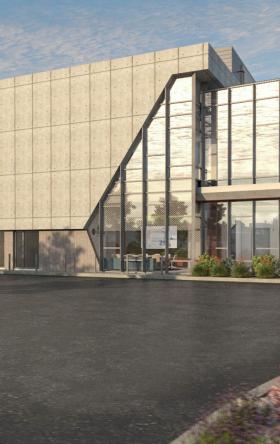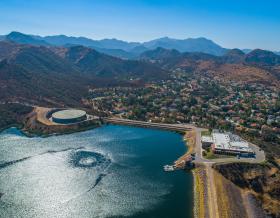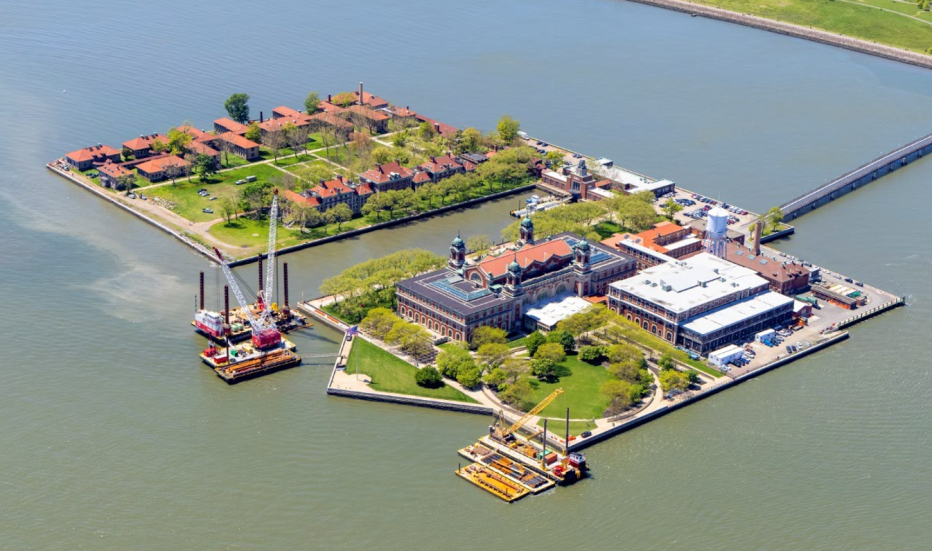
Photo credit to Weeks Marine, Inc.
Preserving a landmark
The Ellis Island National Museum of Immigration, part of the Statue of Liberty National Monument, is located at the historic Ellis Island Immigration Station in New York Harbor. The museum and statue have been a beacon of hope for many generations of immigrants and visitors to the United States. It also boasts a broad archaeological and historical heritage, from its first known function as an oyster island providing food to Native Americans to its use by the U.S. military for harbor defense to the first federal immigration depot in the United States. Today it tells the story of the hopes and dreams of the millions of immigrants that passed through its doors from 1892 to 1954.
Managed by the National Park Service (NPS), this iconic landmark is protected from harsh New York Harbor conditions by a seawall—a series of structures ranging from 90 to 110 years old. The seawall’s age, structural deterioration and other challenges prompted the NPS to have Jacobs investigate the extent of degradation, subsequently designing and overseeing the structural repairs and rehabilitation. The seawall fortifies the footprint and foundation of the island, with this critical project delivering continued protection of this historic landmark for this and future generations of visitors.
-
2 M
Annual visitors to the site, it was vital that our work did not affect these visitors’ experience of the historic site or their safe access to it.
-
6450 LF
Built in phases between 1913 and 1934, the seawall length in feet involves various structural configurations and support systems.
Combining innovation and preservation
Repairing seawalls is challenging enough, requiring above and under water structural investigation and repair. This project included added complexities of the historic nature of the seawall, which required adherence to The Secretary of the Interior’s Standards for the Treatment of Historic Properties requiring respect to maintain its original character while providing resiliency for the future and keeping the thousands of daily visitors safe. We achieved these sometimes-conflicting goals by:
- Designing a steel sheet pile system to support the wall while being completely invisible to the visiting public above water.
- Replacing visible wall portions using as much of the original, historic stone as possible combined with new stone from the same types of quarries and by color-matching, new mortar and concrete.
- Ensuring safety for the visitors brought by ferries to the island while also protecting the island from wave damage at the ferry berths.
- Using temporary berths and phased construction allowing 100% public access and avoiding disruption to the experience, all while providing repairs to keep that experience alive for future visitors.
- The post-construction condition restored the structural integrity of the existing seawall and provided an upgraded fender system while maintaining the historic look of the original timber fender system.
Despite repair and construction challenges, visitors enjoyed this historical landmark throughout the project. The team’s reverence for the historical construction of the seawall ensured that the experience of visitors today, or in 50 years, looks and feels the same as the experience of immigrants on the island more than 100 years ago. By engaging our values of aiming higher and challenging the accepted, we developed solutions that maintained the site’s historical integrity while introducing effective innovations to protect this treasured landmark for generations.
Jacobs’ dedication to innovation and our commitment to the values of the NPS enabled us to address the needed repairs for this high-visibility, historic seawall. We delivered a thorough, historically sensitive restoration focusing on safety for visitors, the ferries carrying them, and the site itself—all without disrupting the experience of Ellis Island’s beauty and significance.
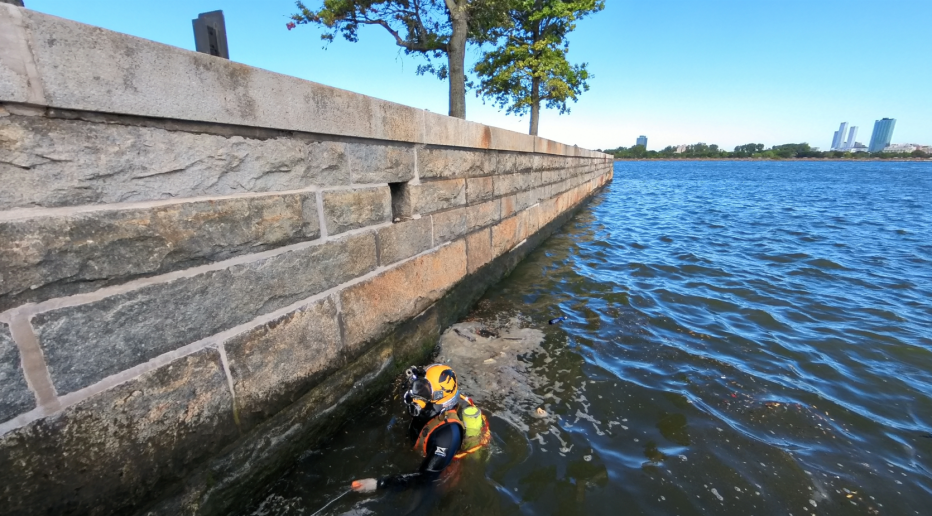
Jacobs diver inspecting the seawall
“Through the work at Ellis Island, we are protecting American heritage while delivering a resilient and safe seawall – allowing visitors to enjoy this cultural site for generations. By working alongside the National Park Service, we are committed to the preservation and sustainability of our historic landmarks.”
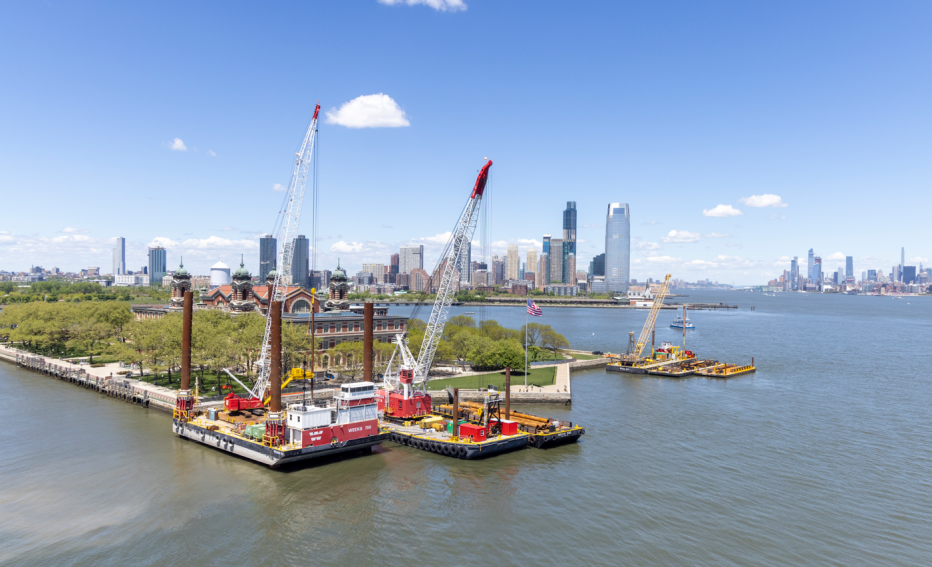
Photo credit to Weeks Marine, Inc.
You might be interested in...
-
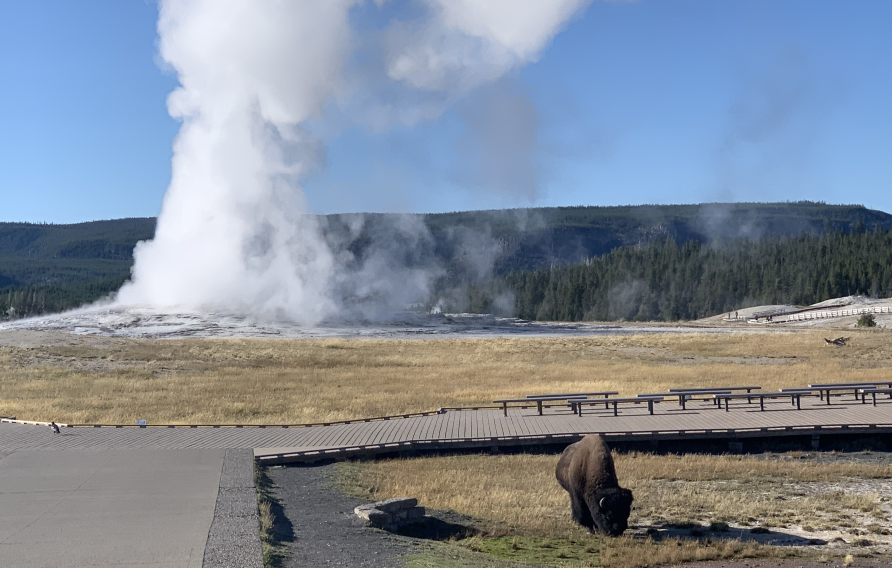 Showcase
ShowcaseJacobs and the National Park Service
Providing architectural and engineering services for our National Parks since 1971, Jacobs continues to protect, restore, rebuild and enhance America’s magnificent parks for the future.
-
 News
NewsQ&A: Talking with Michele Holland, Federal Civilian Agencies Portfolio Operations Director
Michele Holland, PE, PMP, is the Federal Civilian Agencies Portfolio Operations Director. A graduate of Virginia Tech with a Bachelor of Science in Civil Engineering and a Master of Science in Structural Engineering, Michele began her career designing large infrastructure and facility projects in the Washington D.C. area before moving overseas to support bridge and infrastructure projects in Gurgaon, India and then on to deliver program management support in Dubai, United Arab Emirates. Michele joined Jacobs in 2011 as a Project Manager in the Arlington, Virginia office. She has since moved to Raleigh, North Carolina where she is on a never-ending quest to find the best craft beer and BBQ in the state.
-
 Showcase
ShowcaseMeet Mónica Quiñones
Project Management Principal Mónica Quiñones never backs down from an opportunity. Whether being the only woman in a classroom, relocating as part of being a military spouse, or taking on a new project, Mónica is ready for anything.


